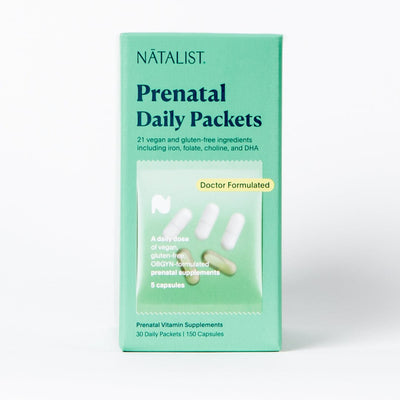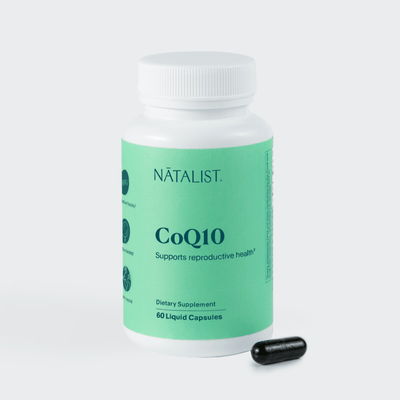Day 3 vs. Day 5 Embryo Transfer: A Guide

By OBGYN Dr. Kenosha Gleaton
Some of this content has been repurposed from Natalist’s Guide to IVF, written by Halle Tecco and medically reviewed by Dr. Dana McQueen.
Deciding to have a baby comes with a lot of decision-making. You and your partner will need to have conversations about finances, names, holidays, and more, and if you’re undergoing fertility treatments, there are even more conversations to be had. Let’s discuss IVF embryo transfers, and compare and contrast day 3 vs day 5 embryos.
Understanding Embryo Development Stages
When someone gets to the embryo transfer stage of IVF, they have already been through many hormone and medication injections and an egg retrieval, and are now ready for the provider to insert or transfer an embryo into the uterus. [1] Before this transfer can occur, an embryo must be selected that will have the best chance of leading to a viable pregnancy. This is where the day 3 vs day 5 conversation comes in. Is it better to use an embryo that has been developing for three days after fertilization or an embryo that has been developing for 5-6 days?
Day 3 (Cleavage Stage)
A day 3 embryo is in the cleavage stage, meaning the embryo has begun to divide from a one-cell embryo into a multicellular organism. [2] Day 3 embryos are graded using two different criteria, the number of cells in the embryo and the appearance of these cells under a microscope. [2] Typically, a good, normally growing day-3 embryo will have between 6 and 10 cells of equal size with little to no fragmentation, which is a term to describe a small portion of the cytoplasm that breaks off from the embryo. [2] Embryos with 6-10 cells are more likely to continue to develop into viable blastocysts than day-3 embryos with fewer cells. [2] Learn more about embryo grading →
Day 5 (Blastocyst Stage)
A day 5 embryo is in the blastocyst stage, meaning it has developed into a rapidly dividing ball of cells. [3] While most are familiar with “day 3 vs day 5” terminology, an embryo may reach the blastocyst stage on day five, six, or seven of development. [2-4] In a blastocyst, the inner group of cells (the inner cell mass, ICM) will eventually become the fetus, while the outer group (trophectoderm epithelium, TE) becomes a protective layer and will eventually make up the tissues needed to sustain a pregnancy. Day 5 embryos are graded on the development of the blastocyst, which can be observed based on the number of cells as well as whether or not cell types are distinguishable. [4]
The Shift Towards Day 5 Transfers
In general, we’ve seen an increase in the number of clinics and providers recommending blastocyst-stage (day-5) transfers over cleavage-stage (day-3) transfers. [4-5] There are a few reasons for this. For one, blastocyst-stage embryos tend to have higher implantation rates, a likely result of the embryos being more mature. [4-6] There is also an option for genetic testing, known as preimplantation genetic testing (PGT), with day 5 embryos, further increasing the chances of someone having a chromosomally normal embryo. Day 5 embryos are also better aligned with the state of the uterine lining, as implantation without the use of IVF generally occurs around days 5-7. [4-6] Some clinics will still perform 3-day and 5-day transfers, so you should do your research and have a conversation with your provider if you have questions or concerns about your embryo transfer.
Is a 3 Day or 5 Day Transfer Better?
The day 3 vs day 5 embryo transfer is a hotly debated topic among clinics, providers, and IVF patients. While we are seeing a bit of an increase in day 5 embryo transfer, there are some pros, cons, and considerations for each.
Pros and Cons of Day 3 Embryo Transfer
Patients do tend to have more embryos available for transfer on day 3 than on day 5, though this doesn’t mean there is a higher likelihood of day 3 embryos implanting or progressing into a viable pregnancy. [4] Researchers notice a gradual decrease in viable embryos at every stage of development. Say someone has 10 eggs retrieved, it’s normal to see about 7-8 of these fertilize, with only 5-6 making it to day 3, and even fewer (2-4) making it to day 5. [4] (This is known as the IVF Funnel, read more here!) So, even if there are more embryos to choose from around day 3, there is no guarantee that the embryos will survive after being transferred to the uterus (though the same argument can be made for day 5 embryos). [4-6] On the other hand, there is no way to mimic the uterine environment with 100% accuracy, and there is a potential that some embryos would survive if transferred to the uterus around day 3 instead of continuing to develop in a lab for an extra 2-3 days. [4,7]
Pros and Cons of Day 5 Embryo Transfer
With a 5-day embryo transfer, the embryo is given more time to develop before transferring into the uterus. This can be a huge benefit as the provider can then have a better idea of which of the embryos is most likely to lead to a viable pregnancy. [4] Day 5 embryos have a higher likelihood of being chromosomally normal and can even be genetically tested for inherited diseases and chromosomal abnormalities. [4,6] Additionally, the timing of implantation with day 5 embryos is better synchronized with the uterine lining, as unassisted implantation would normally occur around days 5-7. [4-6] This being said, the American Society for Reproductive Medicine (ASRM) has suggested that blastocyst-stage embryos may be associated with a small increased risk of adverse outcomes, although more data is needed. [6] Additionally, not all patients will have day-5 embryos to choose from and may have increased chances of a viable pregnancy when using day-3 embryos. [7]
Success Rates and Clinical Considerations
Research results have found mixed results when comparing blastocyst-stage embryo transfers to cleavage-stage embryo transfers. One recent study from June of 2023 included 266 patients undergoing either a day 5 or day 3 embryo transfer. [8] The study found that transferring embryos on day 3 may provide the same benefits as transferring day 5 embryos, however, more day 3 embryos may need to be transferred to see comparable results. [8] Patients from both groups saw no significant difference in clinical pregnancy, implantation, multiple pregnancy, or living birth rates. The researchers did conclude that more research is needed with a larger sample size to fully understand the results. [8] Get early pregnancy test strips >>
Another study with a more comparable sample size found similar results, showing similar pregnancy rates for both day 3 and day 5 transfers (39%). [9] Implantation rates for day 3 transfers were 21%, and day 5 transfers were 24%. Researchers concluded no statistically significant difference between these rates and agree that day 5 transfers have no advantages over day 3. [9]
On the other hand, the most recent committee opinion (2018) from ASRM states that day 5 embryo transfer results show increased live birth rates compared with the transfer of day 3 embryos. [6]
Keep in mind that there may be clinical considerations that can influence the decision to use day 3 or day 5 embryos. Patients should speak directly to their healthcare team when deciding the best route forward.
Empowering Your Fertility Journey with Natalist
However you have decided to grow your family, you can find helpful information and products from Natalist that can support your family planning goals. Whether you’re in the beginning stages of prioritizing your fertility and reproductive health, or you’re in the throes of breastfeeding and postpartum life, we’ve got you covered. Everyone’s path to parenthood is a uniquely difficult, emotional, and beautiful journey. You shouldn’t have to settle for products that miss the mark. Shop our women’s prenatal vitamin, ovulation test kit, and more evidence-backed, plastic-neutral, and high-quality products here.
Purchase Guide to IVF for more information on the IVF journey.
References:
- Choe J, Shanks AL. In Vitro Fertilization. [Updated 2023 Sep 4]. In: StatPearls [Internet]. Treasure Island (FL): StatPearls Publishing; 2023 Jan-. Available from: https://www.ncbi.nlm.nih.gov/books/NBK562266/
- DAY 3 EMBRYO GRADING. Texas Fertility Center. Accessed December 2023. https://txfertility.com/in-vitro-fertilization-ivf/day-3-embryo-grading/
- Blastocyst. Mayo Clinic. December 2023. https://www.mayoclinic.org/tests-procedures/in-vitro-fertilization/multimedia/blastocyst/img-20008646#
- Magarelli, Paul. November 21 2022. Day 3 v.s. Day 5 Embryo Transfer. CNY Fertility. https://www.cnyfertility.com/day-3-vs-day-5-embryo-transfer/
- De Croo I, De Sutter P, Tilleman K. A stepwise approach to move from a cleavage-stage to a blastocyst-stage transfer policy for all patients in the IVF clinic. Hum Reprod Open. 2020;2020(3):hoaa034. Published 2020 Sep 22. doi:10.1093/hropen/hoaa034
- Practice Committee of the American Society for Reproductive Medicine; Practice Committee of the Society for Assisted Reproductive Technology. Electronic address: asrm@asrm.org. Blastocyst culture and transfer in clinically assisted reproduction: a committee opinion. Fertil Steril. 2018;110(7):1246-1252. doi:10.1016/j.fertnstert.2018.09.011
- Racowsky C, Jackson KV, Cekleniak NA, Fox JH, Hornstein MD, Ginsburg ES. The number of eight-cell embryos is a key determinant for selecting day 3 or day 5 transfer. Fertil Steril. 2000;73(3):558-564. doi:10.1016/s0015-0282(99)00565-8
- Garbhini PG, Suardika A, Anantasika A, et al. Day-3 vs. Day-5 fresh embryo transfer. JBRA Assist Reprod. 2023;27(2):163-168. Published 2023 Jun 22. doi:10.5935/1518-0557.20220027
- Serdar Coskun, Johannes Hollanders, Saad Al-Hassan, Hamad Al-Sufyan, Hend Al-Mayman, Kamal Jaroudi, Day 5 versus day 3 embryo transfer: a controlled randomized trial, Human Reproduction, Volume 15, Issue 9, 1 September 2000, Pages 1947–1952, https://doi.org/10.1093/humrep/15.9.1947
Dr. Kenosha Gleaton is board-certified in gynecology and obstetrics and is the Medical Advisor of Natalist. She received her MD from MUSC and completed her residency at Carolinas Medical Center in Charlotte, NC.
Dr. Gleaton is passionate about women, health equity, and mentoring. She is the CEO of The EpiCentre, an OBGYN spa-like practice, and is a Clinical faculty member of Charleston Southern University. She is also a member of the American College of Obstetrics & Gynecology, the American Association of Gynecologic Laparoscopists, and the American Association of Professional Women.




















